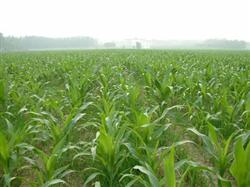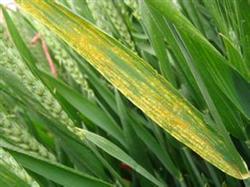There is a wonderful way to prevent wheat freezing injury

Wheat freezing injury is one of the disasters in wheat production in northern China, especially in low temperature and dry years, which greatly affects wheat yield. To prevent frost injury of wheat during overwintering, in addition to selecting varieties with strong cold resistance, the following seven agricultural measures should be taken. The main results are as follows: 1. for the wheat field with insufficient fertilization before sowing, topdressing before winter can consolidate the effective tiller of wheat, increase the sugar content of tiller node and enhance the cold resistance of the plant itself. When topdressing, nitrogen, phosphorus and potassium should be mixed and the proportion should be appropriate. Special attention should be paid to the application of phosphate fertilizer and avoid partial application of nitrogen fertilizer, so as not to cause excessive growth, make the plant stem tissue too tender, and reduce the ability of cold resistance and lodging resistance. Second, cover bran dung and spread 300 kilograms of wheat bran and 400 kilograms of crushed wheat straw per mu between wheat rows in dry land. This method can not only preserve soil moisture and prevent frost, but also improve soil and fertilize soil fertility after mulch is corrupted. It is an effective measure to resist drought, prevent freezing and increase production of wheat. In addition, spreading a layer of manure along the ridge after the wheat enters the overwintering period, commonly known as "warm dung", can avoid the wind, preserve moisture, increase temperature and prevent freezing, and replenish nutrients for the green growth of wheat seedlings. The thickness of dung cover should be 3-4 cm. When manure is insufficient, priority should be given to late stubble wheat fields, shallow sowing wheat fields, sandy wheat fields and wheat fields sowing weak spring varieties. 3. when the growth of wheat seedlings is about to stop before overwintering, combined with hoeing soil surrounding roots, it can effectively prevent wheat from freezing during the overwintering period. In cold, dry and windy years, the anti-freezing effect of soil around the root is particularly obvious, and the yield can be increased by 5% and 10%. Fourth, timely winter irrigation straw to the wheat field or winter drought years, before the arrival of cold air, a winter irrigation. Timely winter irrigation of wheat can significantly protect seedlings and increase yield. Pay attention to timely ploughing and suppression after winter irrigation in order to preserve soil moisture. Fifth, timely ploughing can prevent drought and preserve soil moisture and prevent frost damage. Therefore, it is more important to combine winter irrigation with timely ploughing, especially sticky soil. The soil moisture can be preserved and the temperature can be increased by ploughing more and early ploughing in late stubble wheat field and wet wheat field. Sixth, timely smoking into winter should pay close attention to the weather changes, before the cold spell comes, in the evening to early morning in the field in the field such as wheat bran, straw and other smoke, can reduce freezing damage. 7. Spraying hormones such as wheat before overwintering, especially when there are signs of jointing before winter, should be foliar sprayed with 0.3%-0.5% dwarf hormone before the arrival of cold air. After the beginning of spring, we should pay close attention to the suppression on a sunny day, control the growth of the aboveground part of wheat, or apply soil fertilizer or mud to protect the tillering nodes and young spikes of wheat.
- Prev

Management and Technology of Spring Maize during Summer
At present, spring maize in Qianxi area has entered the jointing stage, which coincides with the peak period of water and fertilizer demand, and it is also the key period of yield formation, so the summer management of maize should be strengthened. First, timely topdressing of corn should be based on nitrogen fertilizer, and it is best to apply it in two stages, that is, 20 kg urea per mu in the big trumpet period.
- Next

Wheat stripe rust can be treated in different areas.
Wheat stripe rust is a serious biological disaster that affects the safe production of wheat in China for a long time. In general epidemic years, the yield of wheat is reduced by 10% by 20%. In extremely epidemic years, the yield can be reduced by more than 60%, and even there is almost no harvest of wheat. According to the comprehensive analysis of the number of bacterial sources, weather conditions and variety distribution, the year 2011 is predicted.
Related
- The first cup of black tea in spring, the flavor and history of tea gardens in Kenya, Africa
- The computer can not only choose potatoes, but also grow tea rice. AI will grow winter oolong tea champion.
- It is not only the inflated tea bitten by insects, but also engraved with the four seasons tea in Beipu.
- The Oriental Beauty Tea Festival in Zhuxian County takes the stage at the weekend to experience the plus-size feast of oil tea.
- & quot; Oriental Beauty Tea & Exploration of Emei in Hsinchu, the hometown of quot;
- The new variety of strawberry "Tainong 1" dessert is the first choice with mellow aroma. Crimson gorgeous
- History of Tea in Taiwan: from Wild Inner Mountain to Export Tea Garden
- Two types of Taiwan Oriental Beauty Black Tea won the British three-Star Award for Childhood Tea Xiang Zhang Jiaqi changed from pilot to champion tea maker.
- Banana species and varieties: the planting history of Taiwan Xianren banana and dwarf banana is long, is banana disease resistant?
- Coffee planting Technology: Qianjie Coffee from Seedling to harvesting

